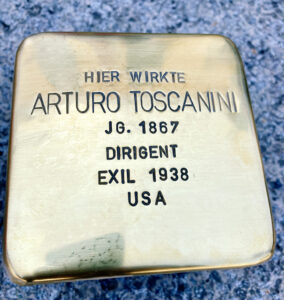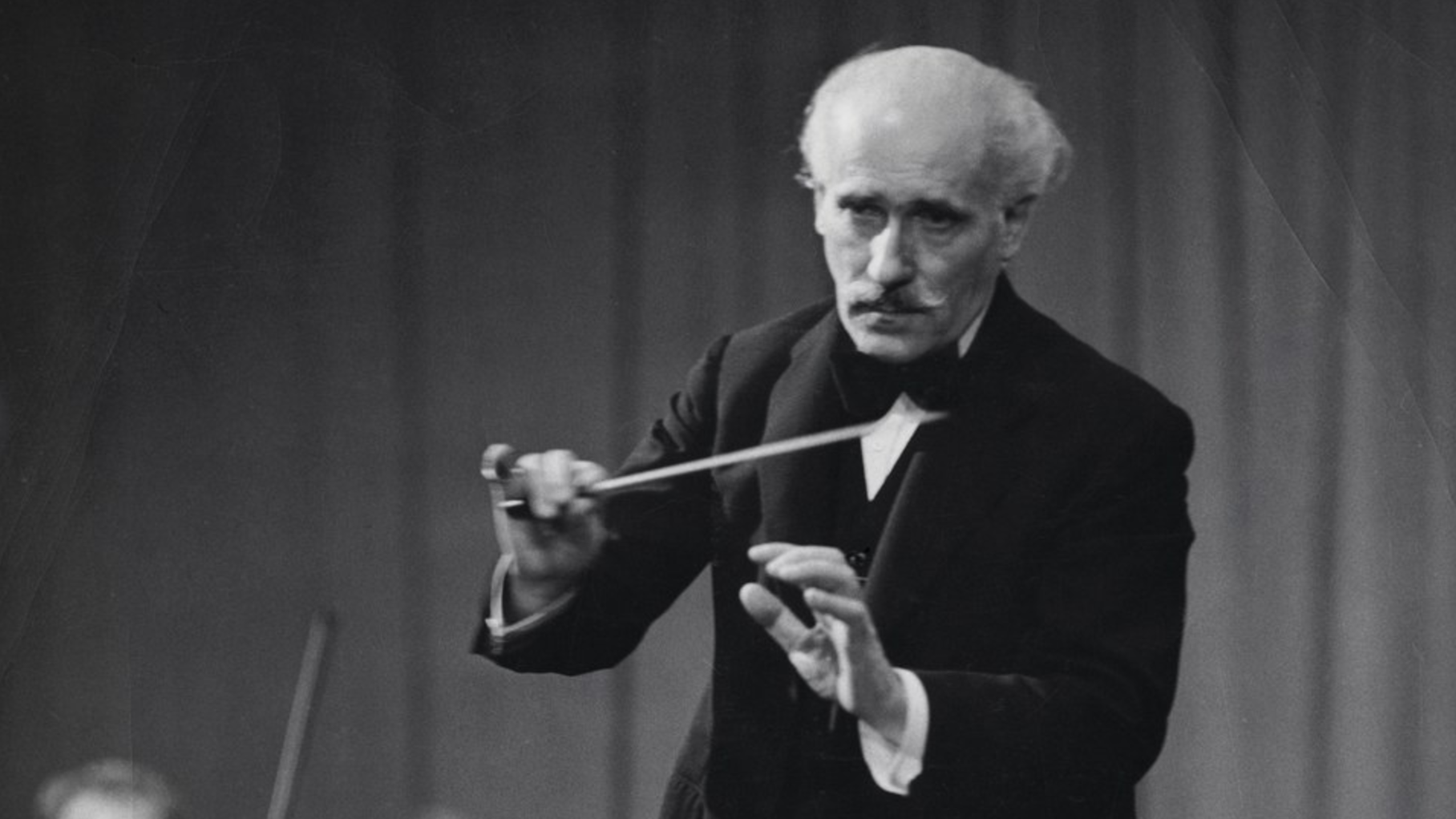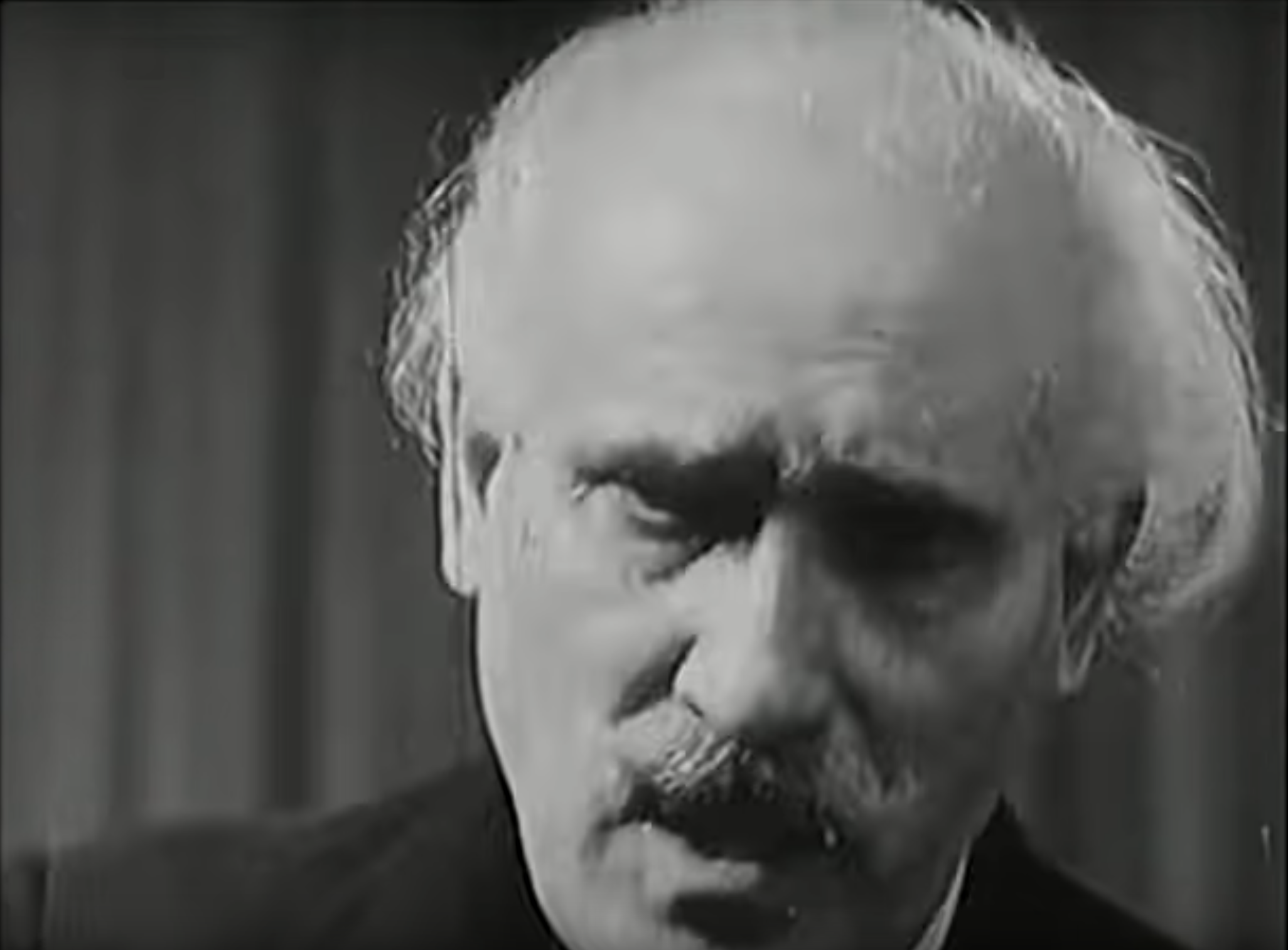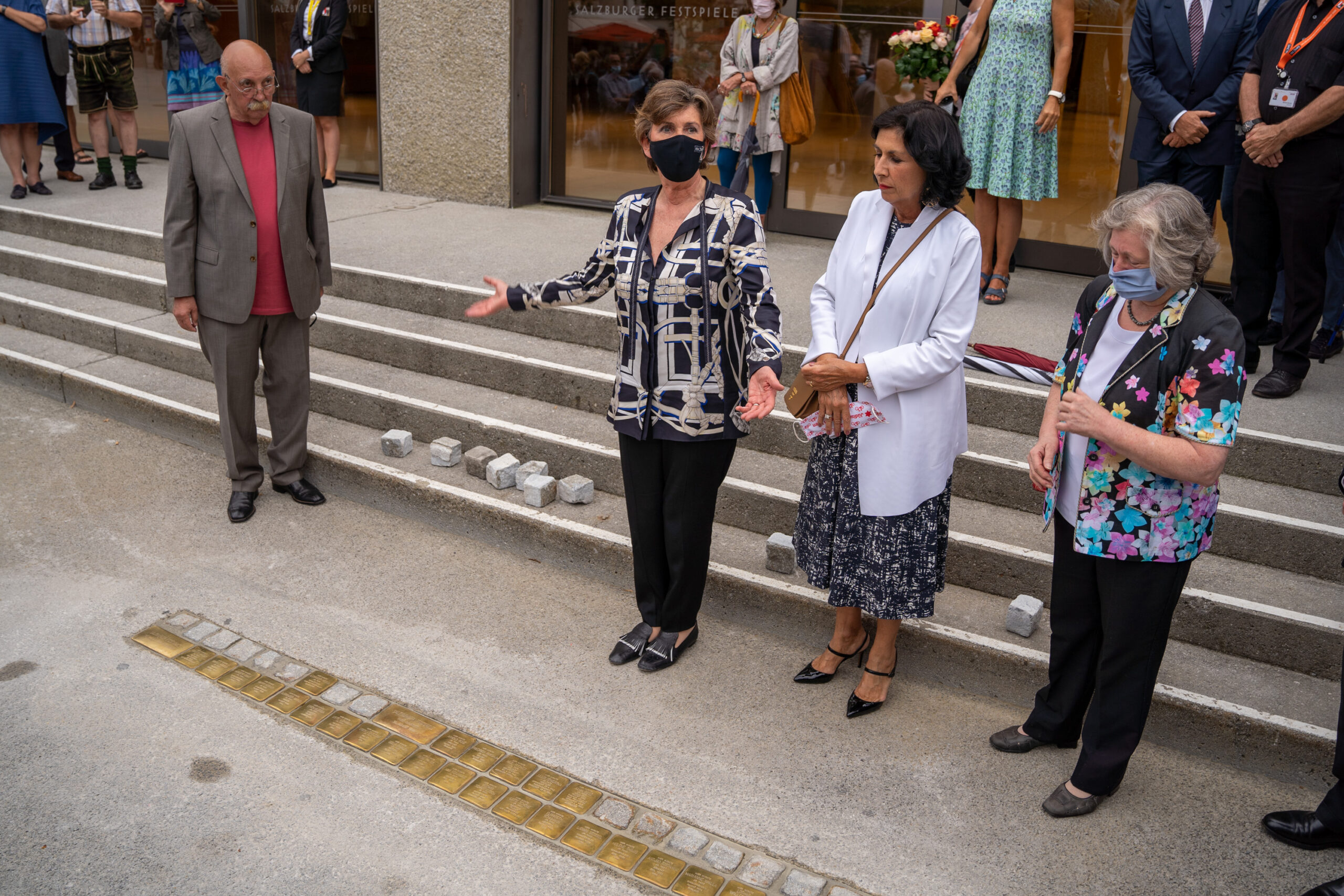Arturo TOSCANINI was born in Parma, Emilia-Romagna, on March 25, 1867 and was married to Carla De Martini. The couple had three children, Walter, Wally and Wanda – a traveling family that regularly commuted between Europe and America while maintain a permanent residence in Milan.
It’s been said that when he was asked how many Jews he employed in his orchestra maestro TOSCANINI replied:
I don’t know, because I do not ask my musicians about their lineage. For me it is only their talent and performance that counts.
TOSCANINI had achieved world fame long before he first took Richard Wagner’s rostrum in Bayreuth in the summer of 1930. As a result, »the spotlight of world interest« focused even more on the Bayreuth Festival – much to the chagrin of the Salzburg Festival, which the press reported had tried unsuccessfully to win TOSCANINI for itself that year.
Vienna too had priority, but TOSCANINI had to cancel the concerts with the Vienna Philharmonic that he had scheduled for the end of May 1931 because he was under house arrest in Italy. At a performance in Bologna he had refused to conduct the fascist hymn Giovinezza and the outraged fascist regime had decided on this as punishment.
But by the summer of 1931 he was free to conduct again at Bayreuth. The following year the Bayreuth Festival was canceled. Its director Winifred Wagner, a close friend of Adolf Hitler, was preparing for the 50th anniversary of Richard Wagner’s death.
In the year 1933 events moved very quickly: Adolf Hitler came to power on January 30th followed by a boycott against Jews on April 1st. That same day there was a protest telegram addressed to Hitler by twelve leading musicians from the USA, with TOSCANINI as music director of the New Yorkers Philharmonic in the first place. Not long after TOSCANINI publicized his decision to quit the Bayreuth festival: he refused to participate alongside Germany’s new rulers – a cultural-political earthquake.
A new attempt to win TOSCANINI for the Vienna Philharmonic was then successful under the Austrian dictatorship. When the new and extremely active head of the board of directors of the Philharmonic, the bassoonist Hugo Burghauser, failed to receive a response to his invitation, the Philharmonic’s renowned violinist Bronislaw Huberman hurried to TOSCANINI’s country seat on Lake Maggiore to get a promise to conduct philharmonic concerts in Vienna from him:
Toscanini’s commitment, a triumph for Vienna.
Die Stunde, October 4, 1933, p. 1
On October 24, 1933, Vienna paid homage to the conductor Arturo TOSCANINI and his congenial orchestra, the Vienna Philharmonic:
… Because this time the magical conductor had a magical instrument at his disposal: the Vienna Philharmonic Orchestra with Arnold ROSÉ as concert master. […]
The storm of applause grew after the »Meistersinger« prelude to a hurricane; the Philharmonic rose from its seats and took part in the frenzied applause for Toscanini. The evening was given a special touch by the presence of Austrian President Miklas, Chancellor Dr. Dollfuss, the diplomatic corps and the leading representatives of Viennese society.
NNeue Freie Presse, October 25, 1933, p. 6
TOSCANINI’s first philharmonic concert proved to be an act of state act for authoritarian Austria. After the second concert in Vienna on October 29, 1933, TOSCANINI gave the hoped-for promise to participate in the Salzburg Festival in 1934. That was politically explosive, because Salzburg was on the border with Nazi Germany and very close to the summer residence of Germany’s Chancellor Hitler at Upper Salzburg (just up the mountain from Berchtesgaden) – a politically and emotionally charged topography with the powerful Hitler leader-myth.
The Salzburg Festival, which was about to be canceled due to the German tourism boycott, the terrorist attacks and the »July coup«, was able to gain tremendous international appeal under TOSCANINI’s leadership. On August 23, 1934, TOSCANINI entered the Festival Hall like a messianic king:
Toscanini sensation. With all the external honors of a great festival sensation, the first Toscanini concert took place on Thursday –with a full house with tickets for every seat sold in advance, an audience mostly of distinguished English, Italian and French visitors, and a show of high fashion evening outfits from Paris, London and Rome during the break.
The radio broadcast of the concert reported on the ecstasy of the audience, which reached Italian levels of enthusiasm. Toscanini was celebrated like a king of his profession […]. Otto Kunz.
Salzburger Volksblatt, August 24, 1934, p. 6
Despite the German boycott, the concerts were more popular than before thanks to international and Jewish solidarity. This was demonstrated clearly when TOSCANINI’s second concert on August 26, 1934, had to be moved from the originally planned Mozarteum concert hall to the larger Salzburg Festival hall because of the unusually strong demand. The concert began with Wagner’s Faust-Ouvertüre and ended with the overture to Die Meistersinger von Nürnberg. In the middle of the program Lotte LEHMANN sang some of Wagner’s Lieder.
Stefan ZWEIG sat in the audience for this concert, a day after he had hosted TOSCANINI and Bruno WALTER – the last illustrious guests in his house at 5 Kapuzinerberg.
TOSCANINI’s third concert was also broadcast by radio and heard by both democratic and fascist music lovers around the world.
After the flourishing Summer Festival featuring Wagner’s music, TOSCANINI made his wish for the next festival clear: either Verdi’s Falstaff or no TOSCANINI. He insisted on conducting the Italian Commedia lirica in Salzburg with members of his former ensemble at the Milan Scala and with the Vienna Philharmonic. Margarete WALLMANN took care of the choreography as ballet director of the Vienna State Opera. The premiere was on July 29, 1935 at the Festival House:
Salzburg experiences Toscanini. Falstaff was a sensational success. This opera evening at the Salzburg Festival in 1935 will be recorded as something unique in the history of Austrian theater and perhaps never to recur: what Arturo Toscanini brought to people from all over the world with his music was at the same time a dream and a fulfillment with cheerful musical theater …
Neues Wiener Journal, July 31, 1935, p. 10
The fascination was called Arturo TOSCANINI. His audience even accepted the Salzburg Festival Theater as a »poor, pitiful festival stage«. For comparison: the Vienna Falstaff, which was staged by Clemens Krauss at the State Opera in December 1934, was not a great sensation despite the new revolving stage. On the contrary, there were loud protests against Clemens Krauss. Since Krauss then emigrated to the German Reich metropolis of Berlin, Beethoven’s Fidelio in Salzburg needed a new director.
It was said that TOSCANINI’s Fidelio in Salzburg (which premiered on August 7, 1935) put previous Festival productions by Franz Schalk, Richard Strauss and Clemens Krauss in the shade: Stefan ZWEIG called it Toscanini’s »Fidelio-miracle«. Lothar WALLERSTEIN directed. Lotte LEHMANN was the celebrated Leonore:
A gorgeous performance, in tone, word and gesture full of noble intimacy.
Salzburger Volksblatt, August 8, 1935, pp. 6f.
In the summer of 1935, TOSCANINI had conducted two operas, three philharmonic concerts and in particular Felix Mendelssohn-Bartholdy’s Reformation Symphony.
Arturo TOSCANINI would have loved to conduct Wagner’s Meistersinger in Bayreuth. However, that was not possible after his cancellation in the 1933 Wagner Year. Now his lifetime wish could be realized in the Mozart city Salzburg: he conducted the Meistersinger von Nürnberg. Herbert GRAF directed, which was not an easy undertaking given the spatial difficulties presented by the Festival House. It premiered on August 8, 1936:
Die Meistersinger in Salzburg. Conductor: Arturo Toscanini. With a tension that had been fueled for months and had grown enormously, now that the dream had become a reality it was greeted with unprecedented enthusiasm. Under Toscanini’s guidance the Meistersinger von Nürnberg made its way into the Salzburg Festival House.
Whatever you hoped and wished for was wonderfully fulfilled. […] it was a great evening of the Salzburg, the Austrian, festival idea. Josef Reitler.
eue Freie Presse, August 9, 1936, pp. 1-3
While Richard Wagner’s Bayreuth served as a Nazi place of worship – »Hitler’s Court Theater« according to Thomas Mann. The festival city of Salzburg positioned itself as the »Gegen-Bayreuth«, at least since the summer of 1933 production of Tristan und Isolde under Bruno WALTER. Richard Wagner continued to be celebrated in Austria, considered flawless. Even Wagner’s well-known tirades against Judaism were considered not worth mentioning.
In the 1936 Summer Festival TOSCANINI conducted Falstaff, Fidelio and two other concerts in addition to the Meistersinger. So it was no surprise to contemporary critics when another opera was added in 1937 under TOSCANINI’s musical direction: Mozart’s Magic Flute in the staging by Herbert GRAF and with Alexander KIPNIS as Sarastro. It premiered in the Festival House on July 30, 1937:
The new Salzburg Magic Flute. For a few years, Mozart’s Magic Flute has been missing from the Salzburg Festival program. Now it has been brought back to life under Toscanini’s strong spirit and this work by Mozart must be the authentic festival opera for the city of Mozart.
Der Wiener Tag, July 31, 1937, pp. 3f
So TOSCANINI directed four operas in the 1937 Summer Festival: Falstaff, Fidelio and Die Meistersinger like last year, and for the first time Mozart’s Magic Flute – »the authentic festival opera for the city of Mozart« and the »Freemason’s Song of Songs« (International Freemasons’- Dictionary).
It is also noteworthy that TOSCANINI gave a special concert on August 24, 1937 to support the building fund for a new Salzburg Festival Theater. At that point there was already a consensus that the old Festival House, which was »neither a festival nor a stage«, merely »poor and pitiful«, had had its day. Arturo TOSCANINI had made his further participation dependent on a renovation or new building.
It was reported that Governor Dr. Franz REHRL traveled to Milan on March 25, 1937 on the occasion of TOSCANINI’s 70th birthday, to present the celebrant with the plans for the new concert house and to thank him in the names of the state and the city of Salzburg:
… At the same time, the governor informed the celebrant of a letter from the mayor of the state capital of Salzburg, according to which the municipality had decided to name the building complex, which was being built as an extension of the festival hall, as the »Toscanini-Hof«.
Salzburger Chronik, March 26, 1937, p. 1
To clarify the matter: the new concert house and not the dark courtyard next to it would be named the »Toscanini-Hof« [»Hof« is German for a Court so the name could easily be mistaken to mean the courtyard rather than the building]. It was clearly intended to be an honor and not a humiliation.
After the splendid run of the Salzburg Festival in 1937, the construction of the concert house began: the National Socialist press across the border raged that it was a »showroom« that only served the »international and Jewish festival hype«. The Nazi Party, which was then banned in Austria, presented itself as an advocate for the little man, fueling envy and hatred of everything privileged and cosmopolitan, which Marlene Dietrich, for example, embodied as a festival guest.
In retrospect, we know that it was Maestro TOSCANINI’s last summer festival in Salzburg. In October 1937 he conducted again in Vienna. It is reported that before the start of the philharmonic concert he hugged and kissed concert master Arnold ROSÉ. The concert proceeds were donated for the building fund of the Salzburg Festival Hall.
At the end of 1937 the program of the Salzburg Festival had already taken shape in 1938: the festive opening of the new »Toscanini-Hof« concert house on July 23, 1938 was scheduled to begin with Mozart Zauberflöte under TOSCANINI. He was supposed to follow this by conducting the operas Falstaff, Fidelio, Meistersinger – and, for the first time, Richard Wagner’s Tannhäuser, five operas in all.
TOSCANINI would therefore have raised the Salzburg Festival to Olympic heights in 1938. He deserves respect for this, but also respect for other reasons.
He reacted promptly to the ultimatum of Chancellor Hitler at Hitler’s summer residence in nearby Obersalzberg on February 12, 1938, before the Nazi Party came to power in Austria on March 12, 1938: TOSCANINI would not take part in the Salzburg Festival under Nazi rulers.
In German-loving Salzburg, TOSCANINI’s rejection found little understanding. On March 4, 1938, the Salzburger Volksblatt, which had celebrated the Verdi, Wagner and Mozart conductor for four festival summers, denounced TOSCANINI, as a »German hater«, »Freemason and Jew-friend«, who was already in any case unacceptable for the Salzburg Festival. The stigmatization of TOSCANINI culminated – four days before the »Anschluss« – in the eradication of his name (damnatio memoriae):
There will now be no Toscanini-Hof that would have immortalized a great name.
Salzburger Volksblatt, March 8, 1938, p. 6
TOSCANINI, the shining name of the leading star, to whom the Salzburg Festival owes its international appeal, should be wiped out. There was another reason for this: The selective attention of the Salzburg press did fail to notice the fact that in solidarity with displaced German Jewish musicians TOSCANINI had conducted concerts in Jerusalem and Tel Aviv in December 1936 and April 1938. This was reflected in anti-Semitic ridicule verses by a house poet of the Salzburger Volksblatt:
Wherever David’s harp whispers, applause thunders for you.
Curly haired Toscanini, you finally feel at home.
by Augustin Ableitner, called »Blasi«
The Salzburg reading public, however, remained uninformed about the background. The violinist Bronislaw Huberman, who had managed to bring TOSCANINI to Vienna and thus Salzburg in the turn of the year 1933, had founded the Palestine Orchestra [the Israel Philharmonic Orchestra since 1948] to save Jewish musicians and their families from persecution – and had been able to do so thanks to TOSCANINI’s participation.
The readers of the Salzburg press also remained uninformed about what was going on in the Vienna Philharmonic Orchestra: in March 1938 – even before the »Nuremberg Racial Laws« came into force in Austria – fifteen Philharmonic musicians, including concertmaster Arnold ROSÉ, were expelled from their orchestra.
Five philharmonic orchestra members were murdered in concentration camps, including Moriz Glattauer, Viktor Robitsek, Max Starkman, Armin Tyroler and the violinist Julius STWERTKA, who also performed with the Rosé Quartet in Salzburg.
TOSCANINI’s refusal to participate in the Bayreuth and Salzburg Festivals under a racist regime was thus not without good grounds.
In exile in the United States, he directed many radio broadcasts with the NBC Symphony Orchestra, which had been founded especially for him. On July 19, 1942, TOSCANINI conducted the Leningrad Symphony by Dmitri Shostakovich in New York as a sign of solidarity with the city of Leningrad (Saint Petersburg), which was being besieged by German aggressors during the Second World War.
In Salzburg, fame faded. The name TOSCANINI was still vaguely remembered, because in the 1950s the side court-yard of the Salzburg Festival Theater – an asphalt spot sandwiched between walls and rocks – was given the name »Toscanini-Hof«: which given the original name for the Festival House was no honor, but rather an ongoing degradation.
So Arturo TOSCANINI did the right thing in never returning to Salzburg. He died in New York at the age of 89 on January 16, 1957.
Sources
- Salzburg Festival Archives
- Salzburg City and State Archives
- ANNO: Austrian Newspapers Online
Translation: Stan Nadel
Stumbling Stone
Laid 17.08.2020 at Salzburg, Max-Reinhardt-Platz

 Arturo Toscanini
Arturo ToscaniniSource: The Imaginative Conservative
 Arturo Toscanini and Salzburg Governor Franz Rehrl at the construction site for the Salzburg Festival Houses 1937
Arturo Toscanini and Salzburg Governor Franz Rehrl at the construction site for the Salzburg Festival Houses 1937Photo: Salzburg City Archives

 Photo: Gert Kerschbaumer
Photo: Gert Kerschbaumer
 The Toscaninihof
The Toscaninihof

 »The Internationale« conducted by Arturo Toscanini
»The Internationale« conducted by Arturo Toscanini
 Relocation of the Salzburg Festival, August 17, 2020 (Max-Reinhardt-Platz): Gert Kerschbaumer, Helga Rabl-Stadler, Danielle Spera, Hanna Feingold
Relocation of the Salzburg Festival, August 17, 2020 (Max-Reinhardt-Platz): Gert Kerschbaumer, Helga Rabl-Stadler, Danielle Spera, Hanna FeingoldPhoto: Salzburger Festspiele/Lukas Pilz
